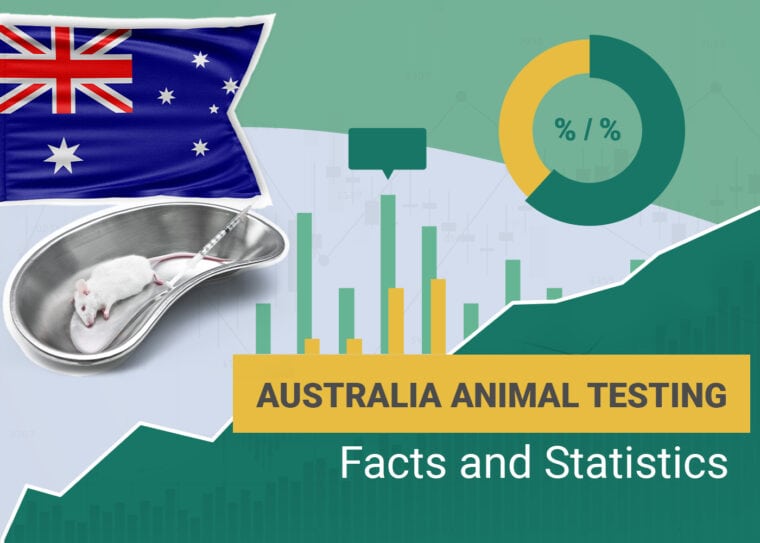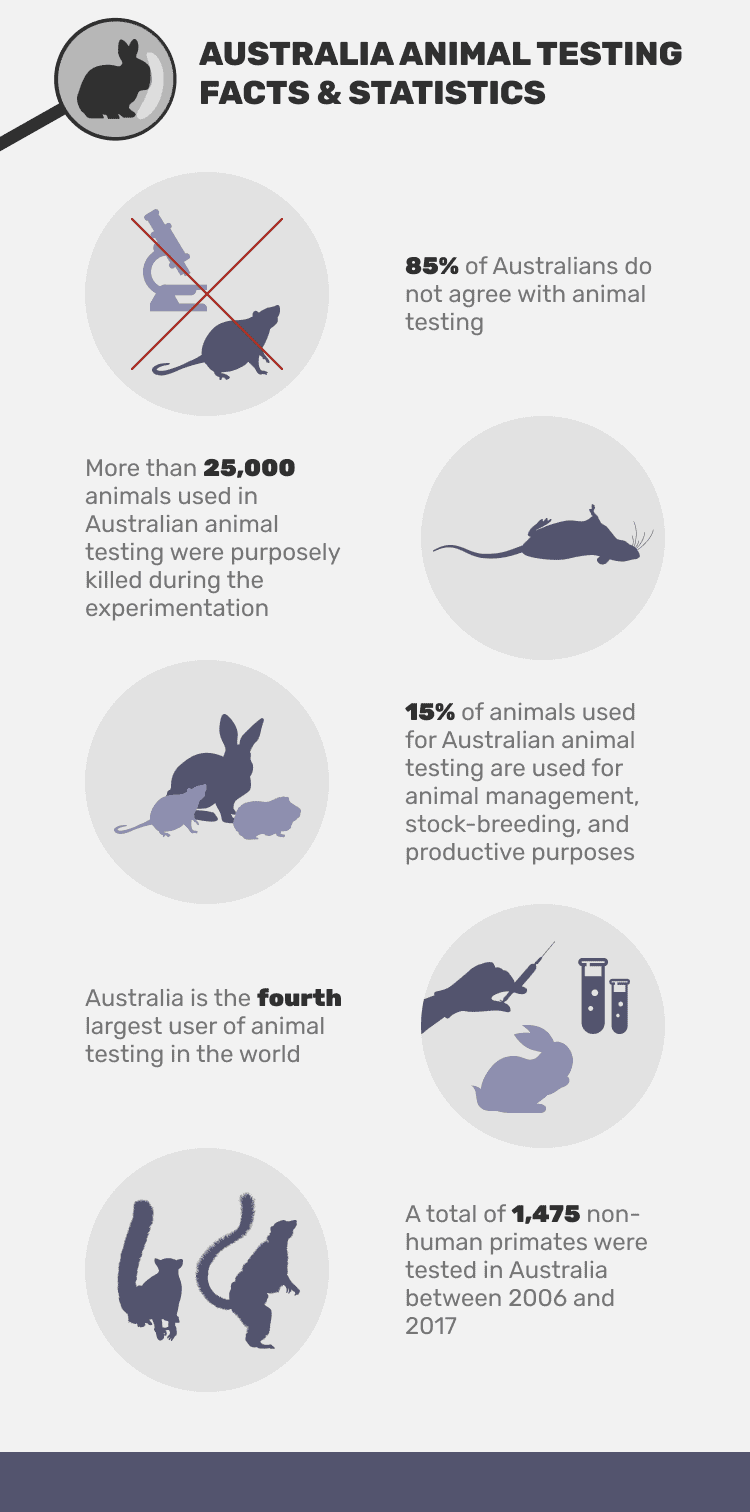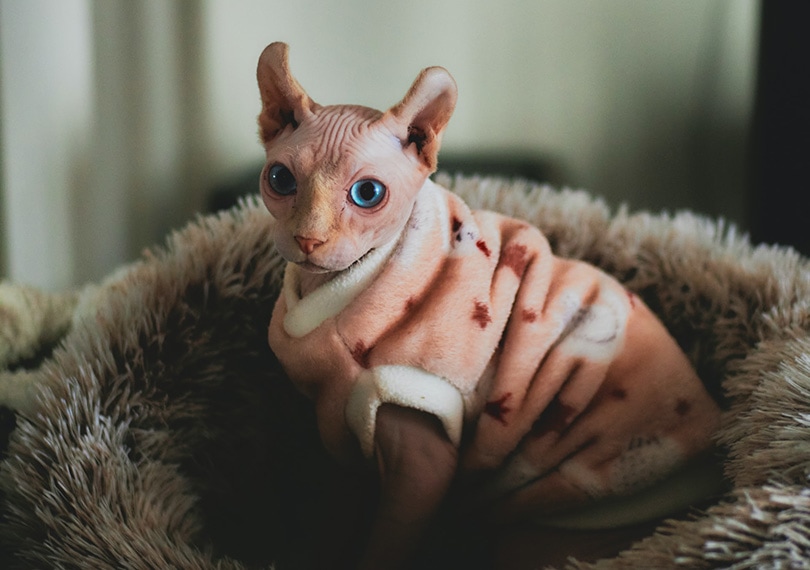
Click to Skip Ahead
Note: This article’s statistics come from third-party sources and do not represent the opinions of this website.
Animal testing is a cruel practice that puts animals through a horrific ordeal in the name of science. Australia is one of the many countries that still conduct tests on animals, usually for medicinal, research, and scientific purposes.
Even though Australia has tried to move in a more positive direction after commencing a ban in 2020 to stop animal testing for cosmetics, they continue to find loopholes to continue to test on animals. The results for animals are death, injury, or severe psychological problems after undergoing these tests.
To animal lovers, the result of animal testing is devastating and continues to be an inhumane practice that needs to be stopped.
Top 10 Disheartening Australian Animal Testing Statistics
- There are more than 6 million animals used in cruel experiments and research in Australia every year.
- While 85% of Australians do not agree with animal testing, only ingredients used for cosmetic purposes are not tested on animals.
- More than 25,000 animals used in animal testing were purposely killed during the experimentation.
- 15% of animals used for Australian animal testing are used for animal management, stock-breeding, and productive purposes.
- There were 12 million domestic fowl subjected to animal testing in Queensland in 2017.
- A total of 1,475 non-human primates were tested in Australia between 2006 to 2017.
- Around 165,777 animals were left unconscious without recovery in Victoria, Australia.
- Mice are one of the most popular test subjects in Australia, with 1,471,837 tested in 2017.
- In 2018, around 10,704,499 animals were tested in Australia.
- Australia is the fourth largest user of animal testing in the world.

Statistics About Animal Testing in Australia
1. There are more than 6 million animals used in cruel experiments and research in Australia every year.
(Animals Australia)
In Australia, more than 6 million animals a year die from being tested. The exact number of animals that are tested in Australia varies each year, with some numbers being double the annual average. With approximately 100 million animals being tested each year, Australia averages around 6 to 21 million animals tested annually in the country.

2. While 85% of Australians do not agree with animal testing, only ingredients used for cosmetic purposes are not tested on animals.
(RSPCA)
Approximately 85% of Australians are opposed to animal testing, and even with the new ban on the 1st of July 2020 that prohibited animal testing for cosmetic ingredients, other products unrelated to cosmetics are still tested on animals.
This ban has not stopped animal testing in Australia, and it has only banned a small portion of animal testing in the country. Even though the ingredients might not be tested on animals for cosmetic purposes in Australia, this does not guarantee that the brand of cosmetics you are using does not test on animals in other places in the world.
3. More than 25,000 animals used in Australian animal testing were purposely killed during the experimentation.
(PETA)
Animals that are experimented on in Australia and facilities worldwide are put through immense torture that has horrifying outcomes. If the animal doesn’t die after being put through the test or suffers in pain either physically or mentally, the animal is tested until they are purposefully killed, also known as “death as an endpoint”. According to PETA, this is around 25,000 animals a year.
This can take anywhere from a day to months, and many animals are not euthanized if they are severely injured, but rather left to die. If the experimentation does not kill the animal first, they are usually left with major psychological problems.
4. 15% of animals used for animal testing are used for animal management, stock-breeding, and productive purposes.
(PETA)
Only around 15% of the tests on animals are used for farming and agricultural purposes. This is a small percentage in comparison to the other categories that make it “necessary” for animal testing in Australia.
5. There were 12 million domestic fowl subjected to animal testing in Queensland in 2017.
(HRA)
In 2017, it was reported that around 12 million domesticated fowl were tested in Queensland, Australia. This means that it doubled from 4.5 million in 2016, to 12 million in just a year. The exact reason for the testing was not specified, but an inquiry into the testing showed that the project was likely non-invasive.
However, it is still concerning to see such an incline in fowl being tested without the Queensland Department of Agricultural and Fisheries explaining the purpose of the experimentation.

6. A total of 4,175 non-human primates were tested in Australia between 2006 to 2017.
(HRA)
Primates such as chimpanzees, marmosets, baboons, macaques, owls, and night monkeys are tested in Australia. A total of 4,175 non-human primates (excluding data from owl monkeys) were put through experiments and research for sensory systems, immunology, vaccine development, and nervous system disorders (NSD) as they are thought to be similar to humans.
The similarity between non-human primates and humans have been disproven countless times, making these tests unnecessary even for scientific purposes.
7. Around 165,777 animals were left unconscious without recovery in Victoria, Australia.
(HRA)
The thought of leaving an animal who is suffering in pain to die without any medical intervention due to purposeful experimentation seems heartless to many, but this is the truth for the animal testing industry. Around 165,777 animals that were being tested on in Victoria were left unconscious, eventually leading to their death.
This means that the harsh experimentation resulted in the animal’s body losing consciousness, but they were not dead yet. These animals were not euthanized or treated for their injuries after the test was completed but rather left for dead.
8. Mice are one of the most popular test subjects in Australia, with 1,471,837 tested in 2017.
(HRA)
Out of all the animals in Australia that undergo testing, mice seem to be the most preferred animal. Rodents are commonly seen as disposable and unintelligent animals that are most responsive and easiest to test on.
However, as sentient beings, mice can feel pain and suffering. As a small and short-lived “test subject”, mice in testing facilities are exposed to chemicals, injections, countless toxins, and inhumane experiments for prolonged periods.
9. In 2018, around 10,704,499 animals were tested in Australia.
(HRA)
Over 10 million animals were tested in Australia in 2018, coming to a total of 10,704,499 animals for the year. This is around 10% of the total animals that are tested on in various parts of the world. The animal testing industry is quite large in Australia, even though they have banned animal testing for cosmetic purposes.

10. Australia is the fourth largest user of animal testing in the world.
(CFI)
Australia fluctuates between the fourth to the fifth largest proponent of animal testing in the world, while China does the most research and animal testing, followed by Japan, the United States, and Canada.
In some data reports, Australia goes back to being the fifth top country that tests on animals, but it seems to stay in fourth place most of the time. The ban on animal testing for cosmetics may have something to do with the data statistics.
Frequently Asked Questions
What Animals Are Tested on In Australia?
(Human Research Australia)
What Types of Animal Testing Happens in Australia?
Procedures are used to test the effectiveness of certain medications, research diseases or biology, or test the reactions and long-term exposures to certain chemicals and food additives. These chemicals, toxins, and ingredients are either given to the animal through an injection, inhalation or applied topically to the laboratory animals’ shaved skin.
This outdated and inhumane practice still exists to test the “safety” of medications and chemicals for humans. Animal testing doesn’t end there, as researchers will conduct other unethical tests on animals, such as electric shock, forced swimming tests, or purposefully cause the animal pain to see how they respond to various treatments.
The animals are used as test subjects for the advancement of human biology, and medication, and to test how safe certain ingredients are that we use in some everyday products. The only procedure that Australia excludes from their animal testing is that they no longer test on animals for cosmetics as of 2020.
(Humane Society International)

Has Australia Banned Animal Testing?
Australia has not officially banned animal testing as a whole, but they no longer test animals for cosmetic purposes. There are still loopholes in this ban, as the brands in Australia that are not cruelty-free certified still test the product of ingredients in the product on animals.
The 2020 ban means that any new ingredients used in cosmetic products in Australia will not be tested on animals to see the ingredient’s safety. Although this is a step forward in the right direction for Australia, millions of animals will still be subject to animal testing in other testing procedures.
(Australian Government: The Department of Health and Aged Care)
What Alternatives to Animal Testing Exist?
Animal testing is now being recognized as a cruel and outdated practice that has plenty of cheaper and more resourceful alternatives. Animal testing is not only costly, unnecessary, and cruel to animals, but it is slowing down our progression in the medical field.
Our new scientific innovations have allowed humans to test the safety and efficiency of substances without having to use a live test subject.
(Open Access Government)
(Cruelty-Free International)
Conclusion
If you have found the reality of animal testing in Australia disheartening, you can do something about it. Many brands have stopped testing their products or the ingredients on animals, and they will have a certified cruelty-free label.
You can make a change by starting to support cruelty-free brands, and support organizations and local campaigns that stand up against animal cruelty in your country.
Related Read:
- Disheartening Canada Animal Testing Statistics To Know
- Disheartening Animal Testing Statistics in The UK
Featured Image Credit: New Africa, Shutterstock







